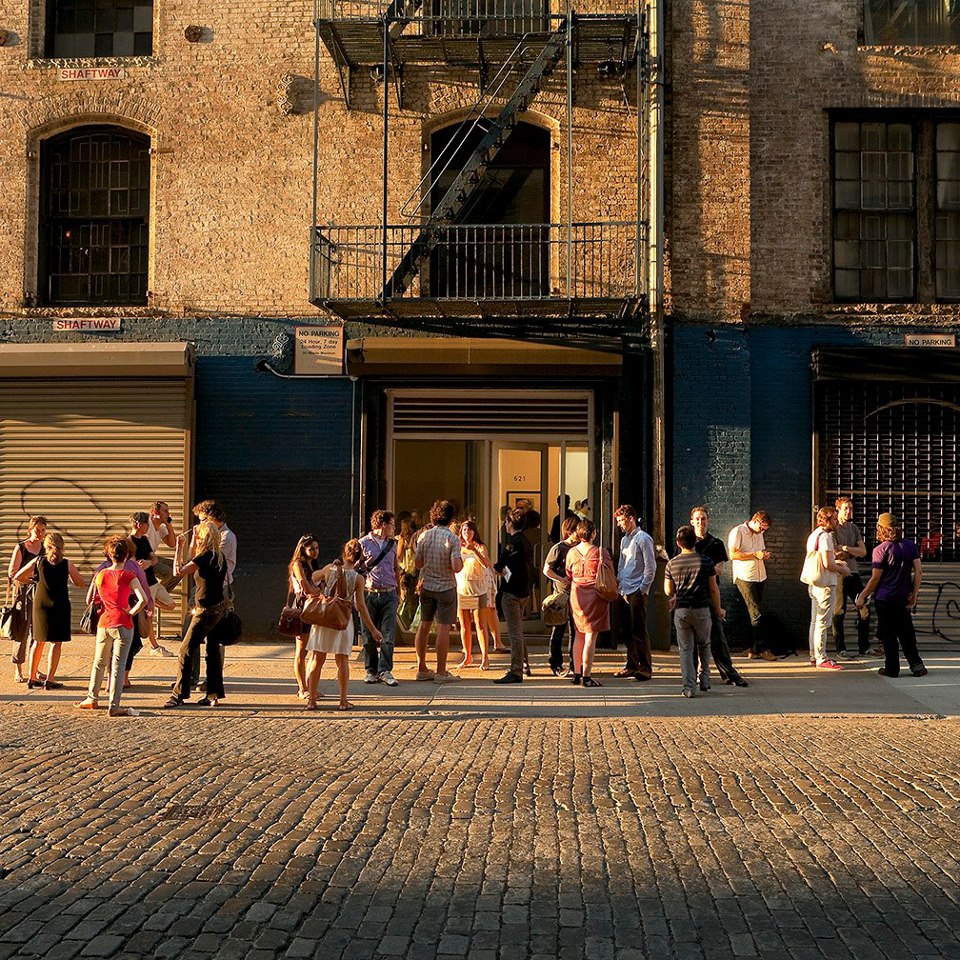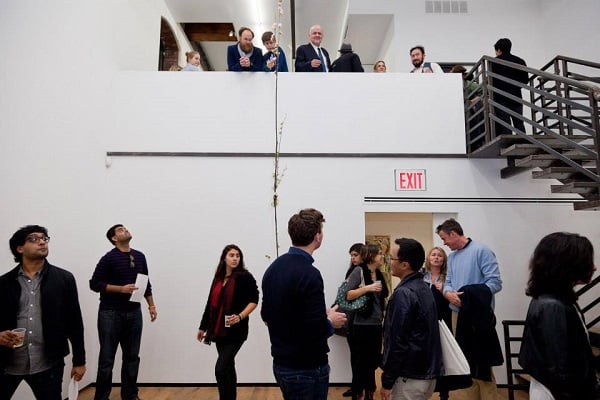Galleries
Are Mid-Size Galleries Disappearing, And Who’s To Blame?
How is the art business changing and who will be left standing?

How is the art business changing and who will be left standing?

Anthony Haden-Guest

It was in 2010 that the DODGE gallery opened at 15 Rivington. It was a two-story space, the bottom story being the most handsome basement space in the city, and Kristen Dodge, who had arrived from Boston, filled it with strong art, mostly fresh to New York.
The gallery quickly came to seem like one to watch, but just after the Armory Show in March this year Dodge announced its closure in an email. Their final exhibition opens this week. A sad event but is it singular? Hardly. Other emerging and mid-level galleries have closed. Should we anticipate the tolling of multiple bells? Ask around and you’ll find this question is on plenty of minds.
Last week, climatologists announced that the world climate was changing much more quickly than predicted. I know the comparison risks bathos, but rapid change is happening in the art economy, too. The dealer Edward Winkleman, who closed his 27th Street space, also last week, says “I was just part of a panel at NYU about navigating the evolving art market.”
Winkleman is writing a book on just that subject and has been interviewing the heads of art funds, auction house chairmen, and fellow dealers. “One thing that keeps emerging when I’m talking with them is that the whole landscape is now so complex that you need expert insights to make sense of it,” he says. “That sounds like we’re entering an era of specialization but the truth is most of what you hear is very general. Nobody really knows! It’s the Red Queen hypothesis. Everything is speeding up. Everybody is running as fast as they can, just to stay in the same place.”
One truism is that the market now governs the art business as never before and that the market is subject to the 99/1 effect, as most markets seem to be these days. What I mean by this is that there is generally one percent of winners in a market and then there is everybody else. Consider World Football, perhaps an even more aggressively financial machine than the American version of the game. Last week—which was a pretty good week for the metaphor business, for me anyway—Diego Maradona, one of the greatest players ever, observed that if his fellow Argentinian, Lionel Messi, a superstar of now, was wooed away from his current club, Barcelona, by Germany’s Bayern Munich, the results would be dire for the game generally. “That would be the end of football,” he said. “Then everyone else would play for second place. In every competition, in every league.”
The art world is differently structured—sports franchises, whether in the US or the world at large, are less likely than the luxury market to be affected by an intervention in the Ukraine or the popping of China’s property bubble. But it goes without saying that the difference that Big Money is making in the art market is one of degree, not kind. Ambitious dealers have always poached artists, knowing that if they don’t somebody else will. That said, pump up the degree enough and it becomes a change of kind too.
“It’ll be a problem if there’s no financial motivation to maintain the gallery system,” Winkleman says. “Very specifically if the mega-galleries continuously approach the bestselling artists from the mid-level or emerging galleries so that those galleries never realize the return on their investments, then I think the nurturing system that we have is in jeopardy. I know that we’re going to see a lot of galleries with some financing and some talented people behind them doing the math and saying this isn’t sustainable to continue doing this.” He added “I think the system is at risk.”
Kristen Dodge was resistant to over-simplifications regarding the 99 percent effect. “The so-called 1 percent have enabled us to run our small businesses, and have enabled many of our artists to make a living,” she observed. “I am not interested in squeezing their diversity of interest, motivation etc. into a uniform and largely contentious category.”

Photo: Courtesy of DODGE gallery, via Facebook.
Fair enough. She also added “I am, however, interested in looking at the limitations of the system as we know it, and locating potential ways to improve the state of art as it exists today. For one, how can more diverse sources of funding, other than the commerce-driven gallery model, be channeled to a broader group of artists, other than necessarily limited gallery rosters, and result in exposing a wider audience to contemporary art? What happens to art when it is less dependent on the commercial market?”
She continued. “As it stands, the dominant version of ‘success’ for artists is… more! More galleries, more shows, more collectors, more money, more bigger, more better. And if you are ‘lucky’ enough to be one of the select few to ride this model, you invariably fall under immense pressure to fill more space more often. This necessitates artists to produce enough work to meet the consuming demands of galleries, collectors, and exhibitions internationally. For artists whose practice lends itself to this level of scale and production, success suits them. For artists who have a much slower and more intimate process, and for artists who want to keep it that way, the dominant model of success is an ill fit.”
There has always been an element of cut-down-the-tall-poppy in the art world’s DNA and another factor is the blowback that artists can experience when they transplant to a more powerful gallery. In our era of Big Moolah, it doesn’t take much for the blowback to turn into a thunderhead.
“There’s about six artists who I know in the last year who had their first show in a much bigger gallery in the last six months,” noted another dealer. “When they were in a smaller gallery the press loved them, loved them, loved them! Everything they did was great! Now all six of them get blasted at the first show they had in a major gallery. And it’s almost the same refrain each time… That the production values were higher… that the need to fill a much bigger space must have influenced them. And in terms of their shows at the smaller galleries, they ended up looking dead.” He singled out Matthew Day Jackson.
“Matthew Day Jackson’s influence on younger artists was really, really high. Hopefully he’ll get some of that back but the Hauser & Wirth show just kinda derailed him. His trajectory. It was bad work. And he should have used half the space.”
Dodge says: “We know that quantity doesn’t equal quality, and we can’t assume that “success” equals greatness.” She cited Theaster Gates and Thomas Hirschhorn as managing to produce terrific, socially relevant work, and also Tino Sehgal, who produces limited salable objects. “The era of big, dumb and shiny is over, thank you!” she observed briskly.
And the risk-level to the gallery system?
“Small and mid-level galleries have the critical job of discovering, launching, and growing the careers of artists,” she observed. “These galleries have no recourse when an artist moves to another program that will capitalize on the investment of time and money they spent to build the recognition and value of their work. The move validates the eye and effectiveness of the gallery that discovered the artist but it is a terrible business model. And to state the obvious, a gallery is a business.”
It also seems fair to ask what happens to art and artists when everything is increasingly dependent upon the internet? Given the heady investment in art e-commerce platforms happening today, you can’t fail to see some correlation between the pressures on mid-size galleries and the ever expanding scope and reach of the internet as a portal to connect buyers and sellers. Will the internet enable art lovers to by-pass completely the gallery structure? Or is this an opportunity for smart dealers to build new models of doing business?
Dodge wont divulge her plans, perhaps because they are not settled, but says she will move on within the art world. She adds that her space has attracted the interest of several established Chelsea galleries. Ed Winkleman now has a broker looking for a new gallery space. “The bulk of where we are looking at the moment is 57th street and the Upper East side,” he says.
There is an irony here, I guess, because this is where the galley world sprouted in New York back in those embattled years when the very notion of an art industry would have seemed like a dark comedy. Bricks and mortar matter, so does location. Some things seemingly don’t change.